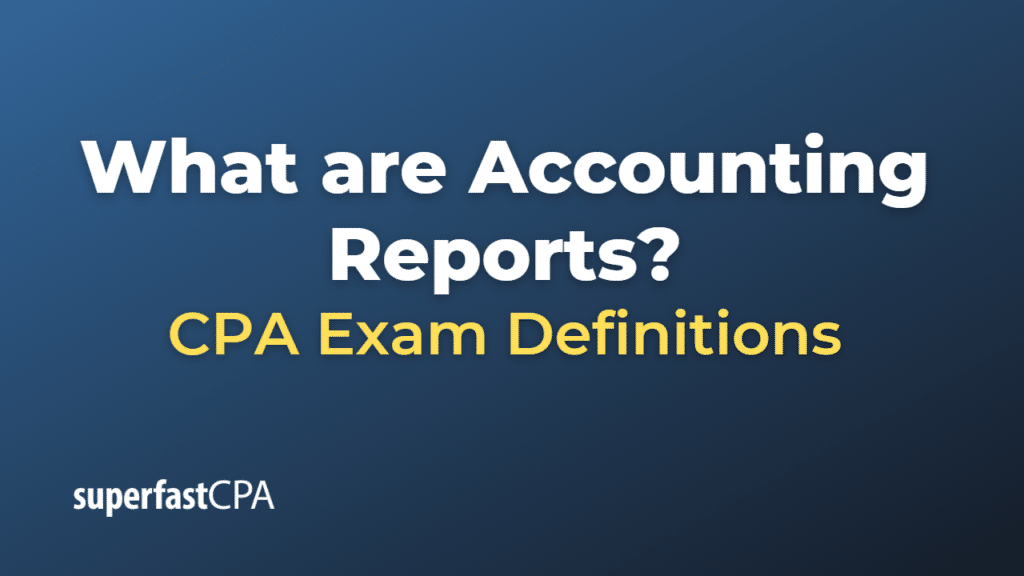Accounting Reports
Accounting reports are financial documents that provide a summary of an organization’s financial transactions, performance, and position over a specific period of time. These reports are used by various stakeholders, including management, investors, creditors, and regulatory authorities, to evaluate the financial health and performance of the organization. The primary goal of accounting reports is to provide accurate, reliable, and transparent financial information for decision-making purposes.
Some of the most common accounting reports include:
- Balance Sheet: Also known as the statement of financial position, the balance sheet presents the organization’s assets, liabilities, and equity at a specific point in time. It provides a snapshot of the organization’s financial health and helps in assessing its liquidity, solvency, and overall stability.
- Income Statement: Also known as the profit and loss statement or statement of operations, the income statement reports the organization’s revenues, expenses, and net income (or loss) over a specific period of time. It provides insights into the organization’s profitability, operating efficiency, and ability to generate returns for its investors.
- Cash Flow Statement: This report shows the inflows and outflows of cash within an organization during a specific period. It is divided into three sections: operating activities, investing activities, and financing activities. The cash flow statement helps stakeholders assess the organization’s ability to generate cash, meet financial obligations, and invest in growth opportunities.
- Statement of Changes in Equity: Also known as the statement of shareholders’ equity, this report outlines the changes in the organization’s equity during a specific period. It includes components such as contributed capital, retained earnings, and other comprehensive income. This report helps in understanding the organization’s dividend policy and how it retains or distributes earnings to its shareholders.
- Notes to the Financial Statements: These are supplemental notes that accompany the primary financial statements, providing detailed information, explanations, and disclosures about the organization’s accounting policies, assumptions, and estimates. The notes help users better understand the financial reports and the context in which they were prepared.
Accounting reports are prepared in accordance with various accounting standards, such as Generally Accepted Accounting Principles (GAAP) or International Financial Reporting Standards (IFRS), to ensure consistency, comparability, and reliability across organizations and industries.
Example of Accounting Reports
Let’s take a simplified example of a fictional company called “Healthy Snacks Inc.” to illustrate the main components of the three primary financial statements:
- Balance Sheet (as of December 31, 2022):
Assets:
- Cash: $50,000
- Accounts Receivable: $20,000
- Inventory: $30,000
- Property, Plant, and Equipment (net): $100,000 Total Assets: $200,000
Liabilities:
- Accounts Payable: $10,000
- Bank Loan: $70,000 Total Liabilities: $80,000
Equity:
- Common Stock: $100,000
- Retained Earnings: $20,000 Total Equity: $120,000
Total Liabilities and Equity: $200,000
- Income Statement (for the year ended December 31, 2022):
Revenues:
- Sales: $200,000
Expenses:
- Cost of Goods Sold: $110,000
- Operating Expenses: $50,000
- Interest Expense: $5,000 Total Expenses: $165,000
Net Income: $200,000 (Sales) – $165,000 (Total Expenses) = $35,000
- Cash Flow Statement (for the year ended December 31, 2022):
Operating Activities:
- Net Income: $35,000
- Adjustments for non-cash items (e.g., depreciation): $10,000
- Changes in working capital (e.g., accounts receivable, inventory, accounts payable): -$5,000 Net Cash from Operating Activities: $40,000
Investing Activities:
- Purchases of property, plant, and equipment: -$20,000 Net Cash from Investing Activities: -$20,000
Financing Activities:
- Proceeds from bank loan: $10,000
- Dividends paid: -$30,000 Net Cash from Financing Activities: -$20,000
Net Increase in Cash: $40,000 (Operating) – $20,000 (Investing) – $20,000 (Financing) = $0
This example is a very simplified version of the financial statements of a company. In reality, each statement will have more line items, and the figures will be more complex. Also, the notes to the financial statements will provide additional information and explanations about the company’s accounting policies and significant transactions.













